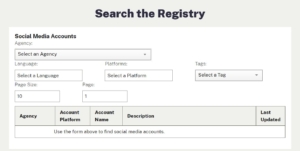Are you taking advantage of all the potential resources to find government contract opportunities to fill your pipeline?
We’ve put together a list of seven sources you should consider in your search for federal contract opportunities. If you’ve read our post, How to Be a Successful GSA Contractor: Five Things You Need to Know, you should be familiar with three of the resources below. However, we’ve also included options you may not have previously considered, along with a few helpful tips.
1) SAM.gov
The System for Award Management (SAM) is one of the primary websites federal agencies use to post contract opportunities. SAM.gov should be your first, but not only resource to find government contracts. Familiarize yourself with conducting searches on SAM.gov, saving your search, and setting notification alerts. It’s important to know how to use the filter options to effectively narrow your results down to relevant opportunities. See our search tips for SAM.gov, along with screenshots here.

2) Agency Procurement Forecasts
While it would be nice if all federal agencies posted their procurement forecasts in the same format in one central location, Acquisition.gov provides the next best thing.
The Agency Recurring Procurement Forecasts page on Acquisition.gov includes a list of federal agencies along with a link to each agency’s procurement forecast page. Be forewarned, there is no set standard for how an agency posts their procurement forecast. However, you’ll find some agencies have user-friendly procurement forecasts that are easy to search.
3) GSA eBuy
If your company holds a GSA or VA Schedule Contract, you have access to an additional resource to find government contract opportunities. GSA eBuy is an online platform that allows government buyers to issue Requests for Quote (RFQs) directly to eligible GSA and VA Schedule Contract holders. By posting an RFQ on eBuy, an agency can typically bypass the requirement to post a full solicitation on SAM.gov.
If you hold a GSA or VA Schedule Contract, make sure someone is responsible for monitoring eBuy and responding to RFQs. Also, keep in mind, your access to RFQs in eBuy is based upon the Special Item Number(s) (SINs) you hold. Search for your NAICS Codes in our SIN lookup chart to see if there are SINs you’re missing out on.
4) Social Media
Over the past few years, there has been a noticeable uptick in the adoption of social media among government agencies. We’ve seen contracting offices that communicate with vendors primarily through LinkedIn Groups, while others post opportunity notices on Twitter. Wherever your target audience is, make sure you’re there as well.
Follow your target government agencies on social media, and you may hear about contract opportunities while they are in the planning stages before an RFI is even released. Use GSA’s US Digital Registry to find out if your federal customers are active on social media and, if so, which platforms they use. The Digital Registry is essentially a directory of agency social media accounts. Select an agency and see a list of their social media accounts with links.
5) Agency Events
It is not uncommon for a federal agency to hold an Industry Day to discuss an upcoming contract opportunity. You may find these events advertised on the agency’s social media platform of choice.
However, there are also unique agency events to be on the lookout for. For example, GSA’s Federal Systems Integration and Management Center (FEDSIM) office helps federal agencies plan contract opportunities to meet their upcoming demands. FEDSIM in turn, holds a “First Fridays” monthly webinar for industry, to discuss and provide updates on contract opportunities the FEDSIM office is working on with their agency customers.
6) Executive Orders
Presidential Executive Orders (EOs) are an indirect resource to find government contracts. They provide insight into an administration’s plans and priorities, which could require industry help to achieve.
Executive Orders can set agency wide goals related to cybersecurity or greenhouse gas emissions, just as an example. EOs can also task specific agencies with creating the process and infrastructure to meet certain goals. These types of directives can translate into upcoming contract opportunities for industry.
You can review Executive Orders on the White House’s website or the Federal Registrar. Monitor releases and review those that might involve your industry. Take note of the terminology used and if specific agencies are cited. Consider using this information to create new Google and/or SAM.gov searches.
7) Subcontracting Directory
If your company is a small business you should look into subcontracting opportunities, if you haven’t already. Prime government contractors are required to establish plans to subcontract to small businesses.
- General Services Administration’s Subcontracting Directory for Small Businesses
- SBA’s Directory of Federal Government Prime Contractors with a Subcontracting Plan
One final note, there is no cost associated with using the resources we’ve put together above. However, if you find you need additional assistance, there is certainly no shortage of paid subscription services that help you identify, track, and manage government contract opportunities.
Be Ready to Capture Contract OpportunitiesContract vehicles like the GSA Multiple Award Schedule (MAS), can help you capture opportunities. Keeping your contracts up to date with your current pricing and offerings puts your company in an optimal position to win when a contract opportunity arises. |



